The Temporal-Spatial Features of Pressure Pulsation in the Diffusers of a Large-Scale Vaned-Voluted Centrifugal Pump
Abstract
:1. Introduction
2. Pump Model and Experimental Setup
2.1. Parameters and Condition
2.2. Model Test Rig, Apparatus, and Method
3. Numerical Simulation Method
3.1. Governing Equations and Turbulence Model
3.2. Pulsation Tracking Network (PTN) with Fourier Transform
3.3. Setup of PTN in Diffusers
3.4. Flow Domain Modeling
3.5. Setup of CFD
3.6. Flow Domain Meshing and Checking
3.7. Experimental-Numerical Verification
4. Result and Discussion
4.1. Pressure Contour and Velocity Vectors
4.2. Pressure Pulsation at Scatter Points in Vaned Diffuser
4.3. Tracking and Visualizing of Pressure Pulsation in Diffusers
4.3.1. Main Frequency
4.3.2. Absolute and Relative Amplitude of Typical Frequencies
4.3.3. Relative Amplitude of Typical Frequencies
4.3.4. Detailed Distributions of Pressure Pulsation amplitudes
4.3.5. Phase and Phase Difference
4.4. Discussions
5. Conclusions
- (1)
- When a large-scale vaned-voluted centrifugal pump is operating at design-load, impeller frequency and blade-excited frequency are the pressure pulsations dominant in diffusers. The impeller frequency of 20 Hz, the blade passing frequency (BPF) of 140 Hz, and its high order harmonics that are 280 Hz, 420 Hz, and 560 Hz can be obviously found. By analyzing the variation law of pressure pulsation in one vaned diffuser channel, attenuations of the BPF and BPF’s harmonics are found along the streamwise direction.
- (2)
- By using the pulsation tracking network (PTN), it is possible to have a more detailed visualization of the source, propagation law, and attenuation law of pulsation frequencies. The BPF series are obviously related to the impeller and vaned diffuser. The BPF series is concentrated in the vaneless region and the inlet of the vaned diffuser channel. The significant influence region and amplitude of BPF have a positive correlation with the sectional area of the volute.
- (3)
- PTN results reveal the propagation and attenuation law of pressure pulsation frequencies in diffusers of the vaned-voluted pump. In the vaneless region, the pressure wave propagates along the radial direction. Vaned diffuser blades (and volute cut-water) have influence on the pressure pulsation. The accumulation effect and the flow-prevention effect of the vaned diffuser will cause local enhancement of amplitude. Hence, the pulsation amplitude attenuation has mainly three stages. In the vaneless region, it is rapid. Near the vaned diffuser, it attenuates first slowly then fast. After the vaned diffuser, the attenuation decelerates.
- (4)
- The phase distribution can indicate sub-flow with certain frequencies. BPF and BPF’s harmonics fluctuate from π to 0 to −π in the vaneless region along the circumferential direction. It shows the circumferential sub-flow driven by the impeller rotation. The outward diffusing pattern of BPF in the volute spiral section shows the sub-flow along the vaned diffuser in the streamwise direction. The fluctuating phase pattern between −0.5π and −π indicates local interference by several sub-flows, with some similar specific pulsation frequencies.
- (5)
- This study only analyzes the BPF and its harmonics at design condition. Considering the simplicity of the operation, the FFT method is selected. It has certain limitations. More reasonable distribution of the PTN points need to be studied, and better frequency domain analysis methods can be used so that more working conditions can be analyzed. The selection of the interpolation method also needs to be improved. This study can be combined with some typical physical phenomena, and further research will be developed in the future.
Author Contributions
Funding
Data Availability Statement
Acknowledgments
Conflicts of Interest
Nomenclature
| constant coefficient | |
| pressure pulsation dimensionless coefficient | |
| amplitude component | |
| a constant term which represents a deviation from zero | |
| the dimensionless coefficient of pressure | |
| the dimensionless radius | |
| the inlet diameter at hub, mm | |
| impeller outlet diameter, mm | |
| total uncertainty | |
| random uncertainty | |
| systematic uncertainty | |
| frequency of pressure pulsation, Hz | |
| the value at the sample point Pi | |
| sampling frequency, Hz | |
| blending function | |
| second auxiliary function | |
| the result of interpolation at the point A to be interpolated | |
| convergence index of the grid of fine mesh and medium mesh | |
| convergence index of the grid of medium mesh and coarse mesh | |
| head, m | |
| design head, m | |
| kinetic energy | |
| Normalized Streamwise | |
| First mesh scheme, fine mesh | |
| Second mesh scheme, medium mesh | |
| Third mesh scheme, coarse mesh | |
| design rotational speed, r/min | |
| specific speed | |
| pressure, Pa | |
| reference pressure at inflow inlet, Pa | |
| the difference between instantaneous and average pressure value, Pa | |
| the maximum pressure on this certain point, Pa | |
| the minimum pressure on this certain point, Pa | |
| observation accuracy order | |
| relative intensity of pressure pulsation | |
| sample point for interpolation | |
| production term of turbulent kinetic energy | |
| generating term of specific dissipation rate | |
| flow rate, m3/s | |
| design flow rate, m3/s | |
| impeller outlet radius, mm | |
| invariant measure of the strain rate | |
| the area of the A polygon | |
| the area of the polygon near the point A | |
| time, s | |
| total acquisition time, s | |
| verage velocity, m/s | |
| fluctuating velocity, m/s | |
| the weight of the interpolation point A | |
| spatial coordinate, m | |
| XYZ | local coordinate system |
| The Fourier series (cosine signal form) of trigonometric function form | |
| impeller blade number | |
| vaned diffuser blade number | |
| constants of the turbulence model | |
| constants of the turbulence model | |
| relative error of extrapolated value of fine mesh and medium mesh | |
| relative error of extrapolated value of medium mesh and coarse mesh | |
| evaluated variables of fine mesh | |
| evaluated variables of medium mesh | |
| evaluated variables of coarse mesh | |
| extrapolated values of fine mesh and medium mesh | |
| extrapolated values of medium mesh and coarse mesh | |
| efficiency | |
| the dimensionless flow rate coefficient | |
| the design dimensionless flow rate coefficient | |
| initial phase angle of each sinusoidal function | |
| dynamic viscosity, Pa·s | |
| turbulent eddy viscosity | |
| circumferential angle, ° | |
| density, kg/m3 | |
| constants of the turbulence model | |
| constants of the turbulence model | |
| specific dissipation rate | |
| rotation angular speed of impeller, rad/s | |
| angular frequency | |
| the dimensionless head coefficient | |
| the design dimensionless head coefficient | |
| BPF | Blade Passing Frequency |
| CFD | computational fluid dynamics |
| FFT | fast Fourier transform |
| PTN | pulsation tracking network |
| RANS | Reynolds averaged Navier Stokes |
| URANS | unsteady Reynolds averaged Navier Stokes |
References
- McKee, K.K.; Forbes, G.; Mazhar, I.; Entwistle, R.; Howard, I. A review of major centrifugal pump failure modes with application to the water supply and sewerage industries. In Proceedings of the ICOMS Asset Management Conference, Gold Coast, Australia, 16–20 May 2011. [Google Scholar]
- Pei, J.; Yuan, S.; Li, X.; Yuan, J. Numerical prediction of 3-d periodic flow unsteadiness in a centrifugal pump under part load condition. J. Hydrodyn. B 2014, 26, 257–263. [Google Scholar] [CrossRef]
- Tao, R.; Xiao, R.; Liu, W. Investigation of the flow characteristics in a main nuclear power plant pump with eccentric impeller. Nucl. Eng. Design 2018, 327, 70–81. [Google Scholar] [CrossRef]
- Yao, Z.; Wang, F.; Qu, L.; Xiao, R.; He, C.; Wang, M. Experimental investigation of time-frequency characteristics of pressure fluctuations in a double-suction centrifugal pump. J. Fluids Eng. 2011, 133, 1076–1081. [Google Scholar] [CrossRef]
- Wei, Z.; Yang, W.; Xiao, R. Pressure fluctuation and flow characteristics in a two-stage double-suction centrifugal pump. Symmetry 2019, 11, 65. [Google Scholar] [CrossRef] [Green Version]
- Guelich, J.F.; Bolleter, U. Pressure pulsations in centrifugal pumps. J. Vib. Acoust. 1992, 114, 272–279. [Google Scholar] [CrossRef]
- Dong, R.; Chu, S.; Katz, J. Effect of modification to tongue and impeller geometry on unsteady flow, pressure fluctuations, and noise in a centrifugal pump. J. Turbomach. 1997, 119, 506–515. [Google Scholar] [CrossRef] [Green Version]
- Morgenroth, M.; Weaver, D.S. Sound generation by a centrifugal pump at blade passing frequency. J. Turbomach. 1998, 120, 736–743. [Google Scholar] [CrossRef]
- Song, H.; Zhang, J.; Huang, P.; Cai, H.; Cao, P.; Hu, B. Analysis of Rotor-Stator Interaction of a Pump-Turbine with Splitter Blades in a Pump Mode. Mathematics 2020, 8, 1465. [Google Scholar] [CrossRef]
- Zhang, Y.; Zheng, X.; Li, J.; Du, X. Experimental study on the vibrational performance and its physical origins of a prototype reversible pump turbine in the pumped hydro energy storage power station. Renew. Energy 2019, 130, 667–676. [Google Scholar] [CrossRef]
- Ran, H.; Luo, X.; Zhu, L.; Zhang, Y. Experimental study of the pressure fluctuations in a pump turbine at large partial flow conditions. Chin. J. Mech. Eng. 2012, 25, 1205–1209. [Google Scholar] [CrossRef]
- Zhang, N.; Gao, B.; Ni, D.; Liu, X. Coherence analysis to detect unsteady rotating stall phenomenon based on pressure pulsation signals of a centrifugal pump. Mech. Syst. Signal 2021, 148, 107161. [Google Scholar] [CrossRef]
- Sinha, M.; Pinarbasi, A.; Katz, J. The flow structure during onset and developed states of rotating stall within a vaned diffuser of a centrifugal pump. J. Fluids Eng. 2001, 123, 490–499. [Google Scholar] [CrossRef] [Green Version]
- González, J.; Fernández, J.; Blanco, E.; Santolaria, C. Numerical simulation of the dynamic effects due to impeller-volute interaction in a centrifugal pump. J. Fluids Eng. 2002, 124, 348–355. [Google Scholar] [CrossRef]
- Parrondo-Gayo, J.L.; González-Pérez, J.; Fernández-Francos, J. The effect of the operating point on the pressure fluctuations at the blade passage frequency in the volute of a centrifugal pump. J. Fluids Eng. 2002, 124, 784–790. [Google Scholar] [CrossRef]
- Zhang, N.; Yang, M.; Gao, B.; Li, Z.; Ni, D. Investigation of rotor-stator interaction and flow unsteadiness in a low specific speed centrifugal pump. Stroj. Vestn.-J. Mech. Eng. 2016, 62, 21–31. [Google Scholar] [CrossRef]
- Wang, H.; Tsukamoto, H. Experimental and numerical study of unsteady flow in a diffuser pump at off-design conditions. J. Fluids Eng. 2003, 125, 767–778. [Google Scholar] [CrossRef]
- Lei, T.; Zhu, B.; Cao, S.; Wang, Y.; Wang, B. Numerical simulation of unsteady cavitation flow in a centrifugal pump at off-design conditions. Proc. Inst. Mech. Eng. Part C J. Mech. Eng. Sci. 2014, 228, 1994–2006. [Google Scholar] [CrossRef]
- Lei, T.; Zhu, B.; Wang, Y.; Cao, S.; Gui, S. Numerical study on characteristics of unsteady flow in a centrifugal pump volute at partial load condition. Eng. Comput. 2015, 32, 1549–1566. [Google Scholar]
- Wang, F.; Zhang, L.; Zhang, Z. Analysis on pressure fluctuation of unsteady flow in axial-flow pump. J. Hydraul. Eng. 2007, 38, 1003–1009. [Google Scholar]
- Zhang, D.; Shi, W.; Chen, B.; Guan, X. Unsteady flow analysis and experimental investigation of axial-flow pump. J. Hydrodyn. B 2010, 22, 35–43. [Google Scholar] [CrossRef]
- Wang, C.; Wang, F.; Tang, Y.; Wang, B.; Yao, Z.; Xiao, R. Investigation on the horn-like vortices in stator corner separation flow in an axial flow pump. J. Fluids Eng. 2020, 142, 071208. [Google Scholar] [CrossRef]
- Jin, F.; Yao, Z.; Li, D.; Xiao, R.; Wang, F.; He, C. Experimental investigation of transient characteristics of a double suction centrifugal pump system during starting period. Energies 2019, 12, 4135. [Google Scholar] [CrossRef] [Green Version]
- Spence, R.; Amaral-Teixeira, J. A CFD parametric study of geometrical variations on the pressure pulsations and performance characteristics of a centrifugal pump. Comput. Fluids 2009, 38, 1243–1257. [Google Scholar] [CrossRef] [Green Version]
- Zeng, Y.; Yao, Z.; Wang, F.; Xiao, R.; He, C. Experimental investigation on pressure fluctuation reduction in a double suction centrifugal pump: Influence of impeller stagger and blade geometry. J. Fluids Eng. 2020, 142, 041202. [Google Scholar] [CrossRef]
- Sun, Y.; Zuo, Z.; Liu, S.; Liu, J.; Wu, Y. Numerical study of pressure fluctuations in different vaned diffusers’ opening angle in pump mode of a pump turbine. In Proceedings of the 26th IAHR Symposium on Hydraulic Machinery and Systems, Beijing, China, 19–23 August 2012. [Google Scholar]
- Sun, Y.; Zuo, Z.; Liu, S.; Liu, J.; Wu, Y. Distribution of pressure fluctuations in a prototype pump turbine at pump model. Adv. Mech. Eng. 2014, 2014, 174–183. [Google Scholar]
- Zhu, D.; Xiao, R.; Tao, R.; Liu, W. Analysis of flow regime and pressure pulsations under off-design condition in pump mode of pump-turbine. Trans. Chin. Soc. Agric. Mach. 2016, 47, 77–84. (In Chinese) [Google Scholar]
- Farzaneh-Gord, M.; Faramarzi, M.; Ahmadi, M.H.; Sadi, M.; Shamshirband, S.; Mosavi, A.; Chau, K. Numerical simulation of pressure pulsation effects of a snubber in a CNG station for increasing measurement accuracy. Eng. Appl. Comput. Fluid Mech. 2019, 13, 642–663. [Google Scholar] [CrossRef] [Green Version]
- Lai, B.; Cui, Q.; Han, L.; Gong, R.; Wang, Q. Pressure fluctuation of 1000 mw model francis turbine. Large Electr. Mach. Hydraul. Turbine 2018, 258, 47–52. [Google Scholar]
- Wu, C.; Zhang, W.; Wu, P.; Yi, J.; Ye, H.; Huang, B.; Wu, D. Effects of blade pressure side modification on unsteady pressure pulsation and flow structures in a centrifugal pump. J. Fluids Eng. 2021, 143, 111208. [Google Scholar] [CrossRef]
- Lin, Y.; Li, X.; Li, B.; Jia, X.; Zhu, Z. Influence of impeller sinusoidal tubercle trailing edge on pressure pulsation in a centrifugal pump at nominal flow rate. J. Fluids Eng. 2021, 143, 091205. [Google Scholar] [CrossRef]
- Posa, A. LES investigation on the dependence of the flow through a centrifugal pump on the diffuser geometry. Int. J. Heat Fluid Flow 2021, 87, 108750. [Google Scholar] [CrossRef]
- Wang, F.; Yao, Z.; Wei, Y.; Xiao, R.; Leng, H. Impeller design with alternate loading technique for double-suction centrifugal pumps. Trans. Chin. Soc. Agric. Mach. 2015, 46, 84–91. (In Chinese) [Google Scholar]
- Zeng, Y.; Yao, Z.; Tao, R.; Liu, W.; Xiao, R. Effects of lean mode of blade trailing edge on pressure fluctuation characteristics of a vertical centrifugal pump with vaned diffuser. J. Fluids Eng. 2021, 143, 111201. [Google Scholar] [CrossRef]
- Tanasa, C.; Bosioc, A.; Muntean, S.; Susan-Resiga, R. Flow-feedback control technique for vortex rope mitigation from conical diffuser of hydraulic turbines. Proc. Rom. Acad. Ser. A 2011, 12, 125–132. [Google Scholar]
- Tanasa, C.; Szakal, R.; Mos, D.; Ciocan, T.; Muntean, S. Experimental and numerical analysis of decelerated swirling flow from the discharge cone of hydraulic turbines using pulsating jet technique. IOP Conf. Ser. Earth Environ. Sci. 2019, 240, 022010. [Google Scholar] [CrossRef]
- Tanasa, C.; Bosioc, A.; Muntean, S.; Susan-Resiga, R. A novel passive method to control the swirling flow with vortex rope from the conical diffuser of hydraulic turbines with fixed blades. Appl. Sci. 2019, 22, 4910. [Google Scholar] [CrossRef] [Green Version]
- Bosioc, A.; Susan-Resiga, R.; Muntean, S.; Tanasa, C. Unsteady pressure analysis of a swirling flow with vortex rope and axial water injection in a discharge cone. J. Fluids Eng. 2012, 134, 669–679. [Google Scholar] [CrossRef]
- International Electrotechnical Commission. Hydraulic Turbines, Storage Pumps and Pump-Turbines-Model Acceptance Tests, 2nd ed.; International Standard IEC 60193; International Electrotechnical Commission: Lausanne, Switzerland, 1999. [Google Scholar]
- Launder, B.E.; Spalding, D.B. Lectures in Mathematical Models of Turbulence, 1st ed.; Academic Press: London, UK, 1972. [Google Scholar]
- Yakhot, V.; Orzag, S.A. Renormalization group analysis of turbulence: Basic theory. J. Sci. Comput. 1986, 1, 3–11. [Google Scholar] [CrossRef]
- Shih, T.H.; Liou, W.W.; Shabbir, A.; Yang, Z.; Zhu, J. A new k-ε eddy viscosity model for high Reynolds number turbulent flows. Comput. Fluids 1995, 24, 227–238. [Google Scholar] [CrossRef]
- Wilcox, D.C. Multiscale model for turbulent flows. AIAA J. 1986, 26, 1311–1320. [Google Scholar] [CrossRef]
- Menter, F.R. Two-equation eddy-viscosity turbulence models for engineering applications. AIAA J. 1994, 32, 1598–1605. [Google Scholar] [CrossRef] [Green Version]
- Wang, Y.; Liu, H.; Yuan, S.; Tan, M.; Shu, M. Applicability of turbulence models on characteristics prediction of centrifugal pumps. In Proceedings of the ASME-JSME-KSME Joint Fluids Engineering Conference, Hamamatsu, Japan, 24–29 July 2011. [Google Scholar]
- Liu, H.; Pan, H. The influence of turbulence model selection and leakage considerations on CFD simulation results for a centrifugal pump. In Proceedings of the Global Conference on Civil, Structural and Environmental Engineering/3rd International Symp on Multi-field Coupling Theory of Rock and Soil Media and its Applications, Yichang, China, 20–21 October 2012. [Google Scholar]
- Al-Obaidi, A.R. Effects of Different Turbulence Models on Three-Dimensional Unsteady Cavitating Flows in the Centrifugal Pump and Performance Prediction. Int. J. Nonlinear Sci. Num. Simul. 2019, 20, 487–509. [Google Scholar] [CrossRef]
- Brigham, E.O. The Fast Fourier Transform.; Prentice Hall: Englewood Cliffs, NJ, USA, 1974. [Google Scholar]
- Sibson, R. A brief description of natural neighbor interpolation. In Interpreting Multivariate Data; Barnett, V., Ed.; John Wiley: Chichester, UK, 1981; pp. 21–36. [Google Scholar]
- Celik, I.B.; Ghia, U.; Roache, P.J.; Freitas, C.J. Procedure for Estimation and Reporting of Uncertainty Due to Discretization in CFD Applications. J. Fluids Eng. 2008, 130, 078001. [Google Scholar]


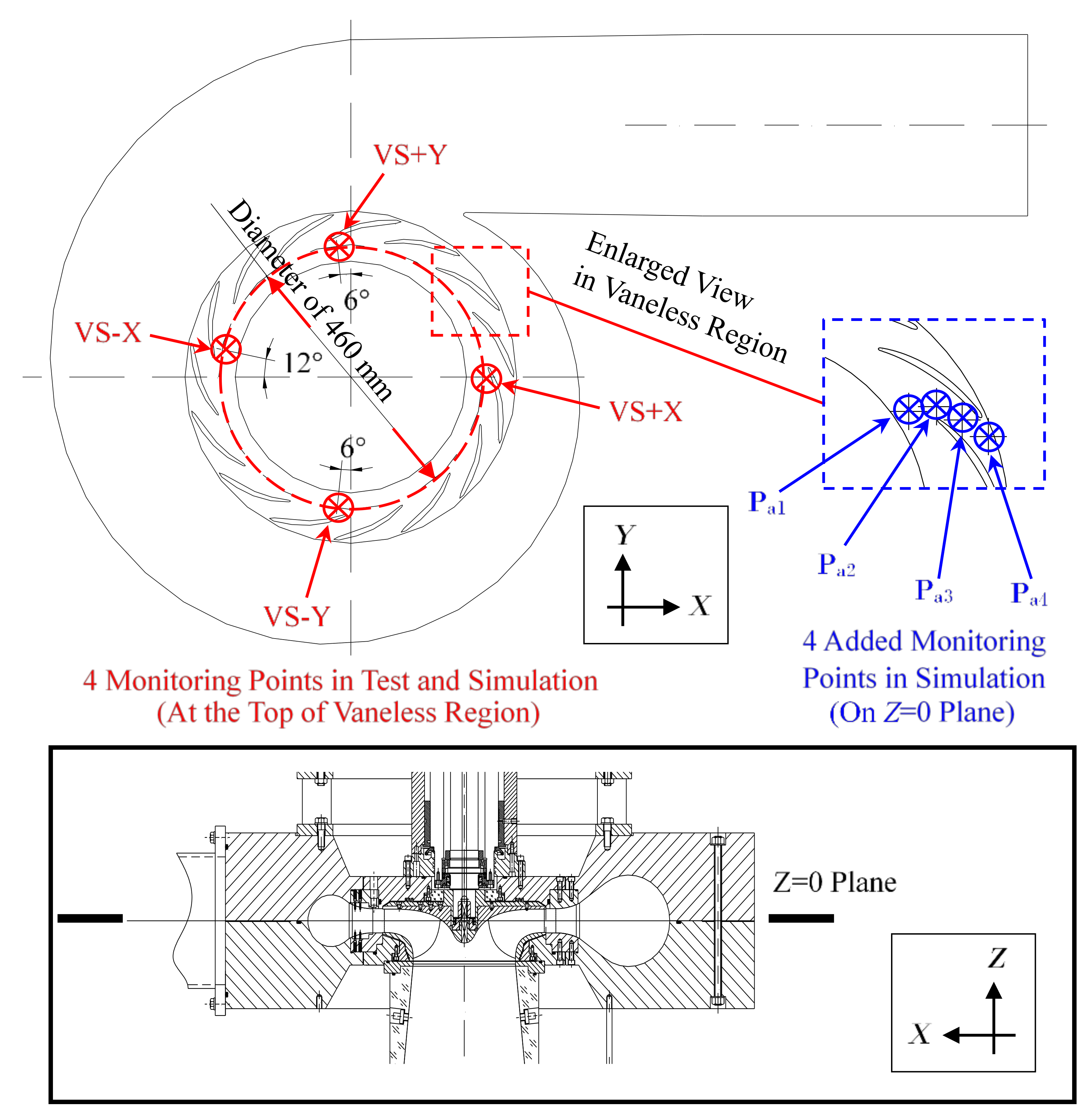
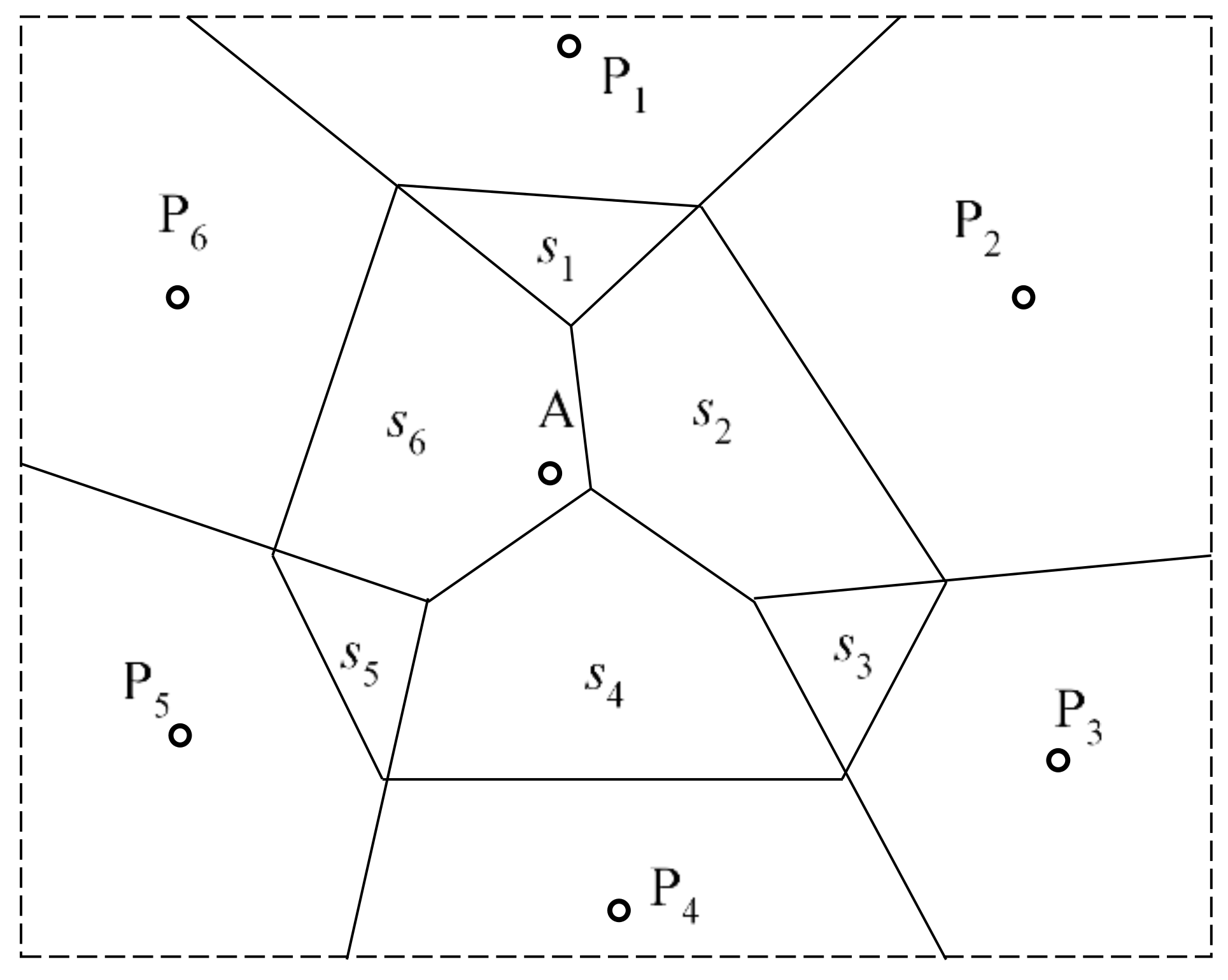

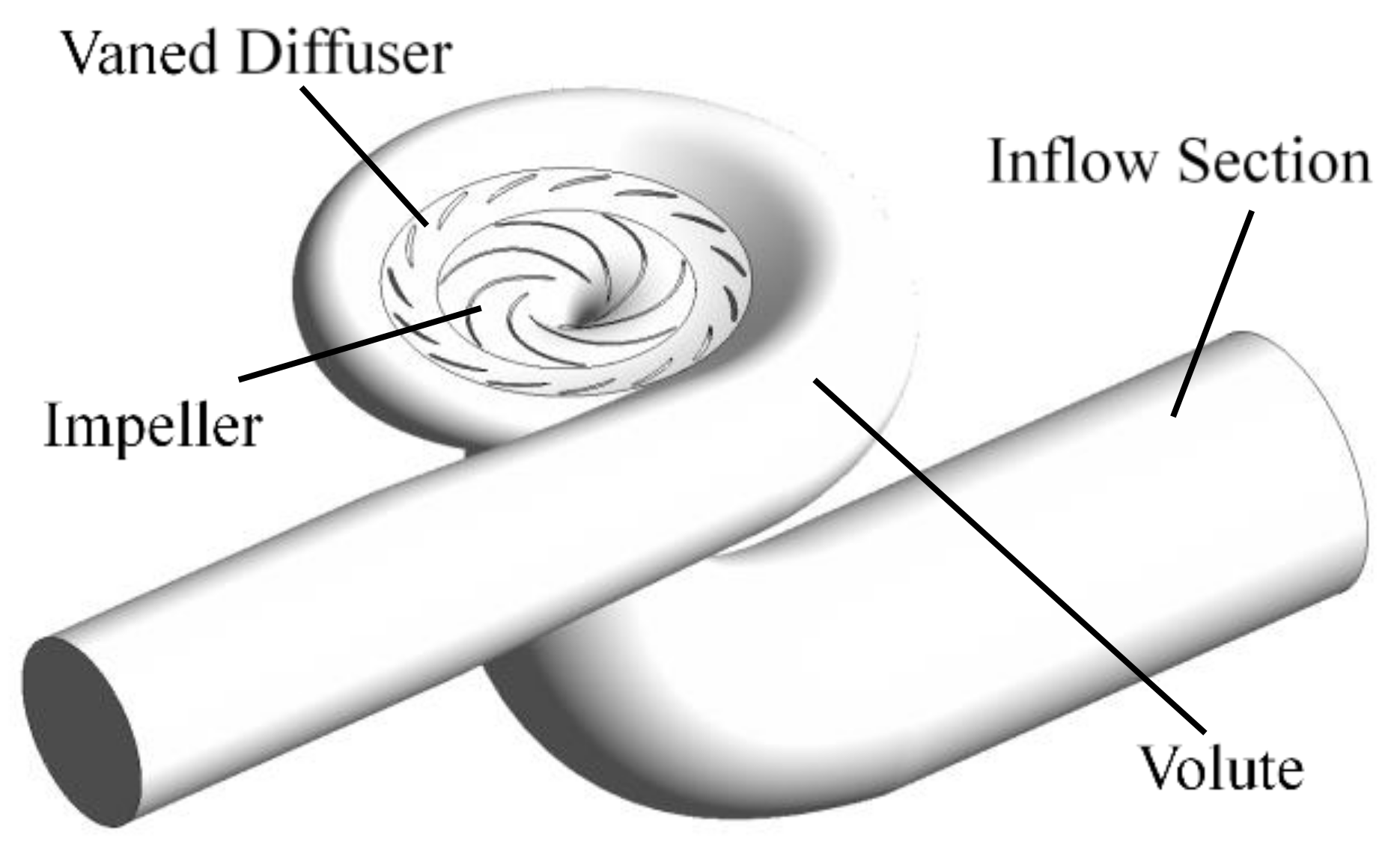
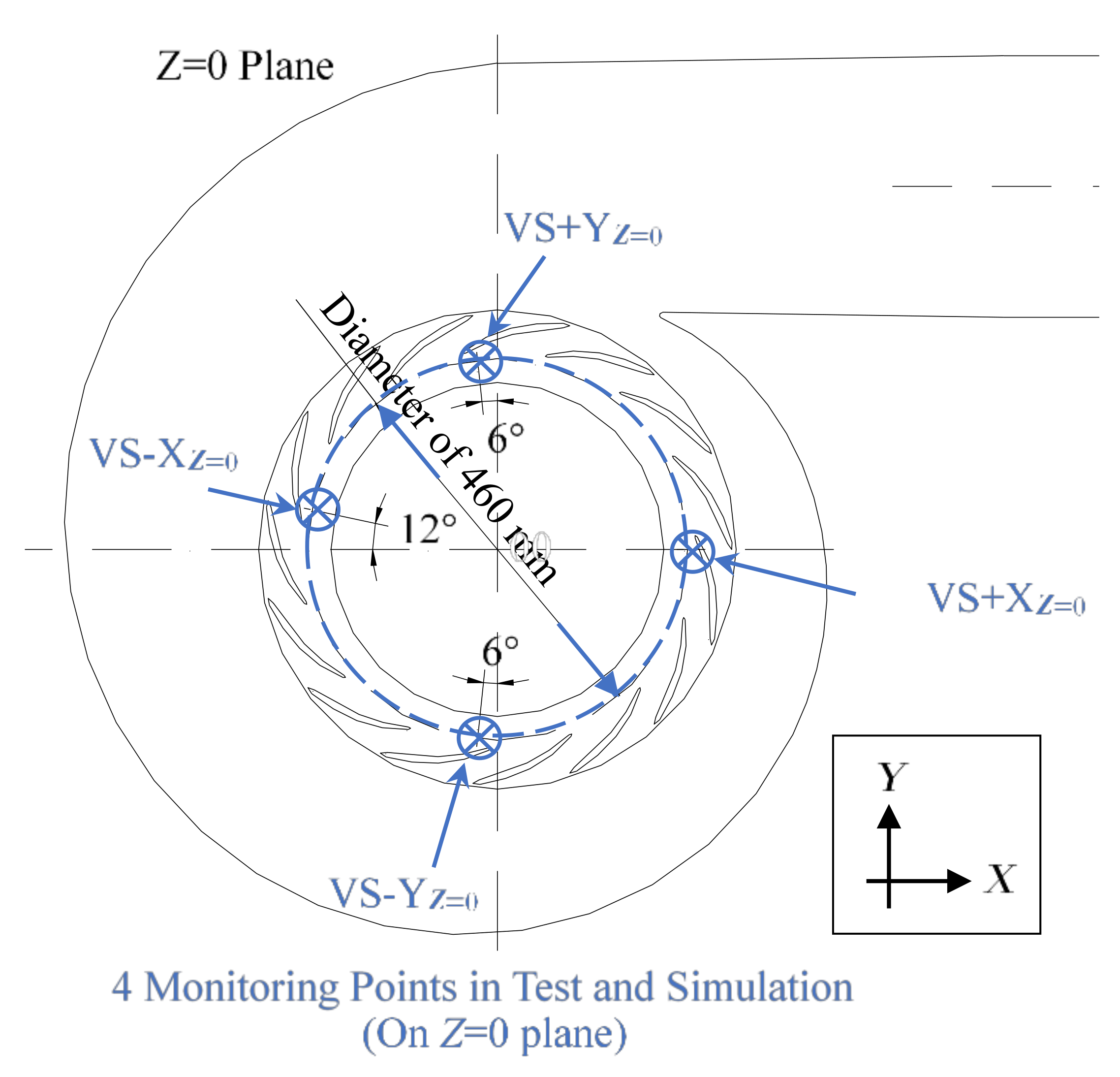
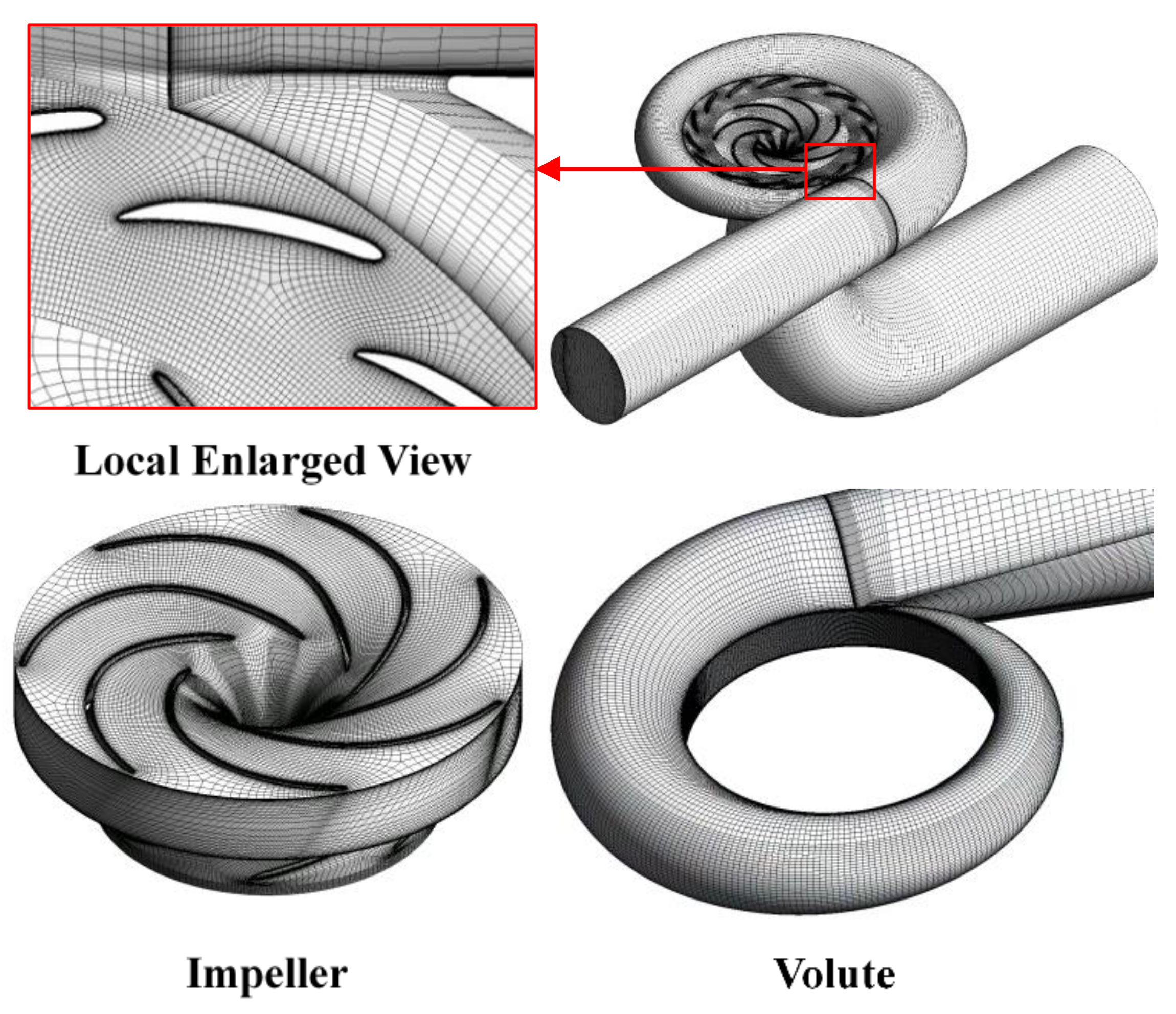
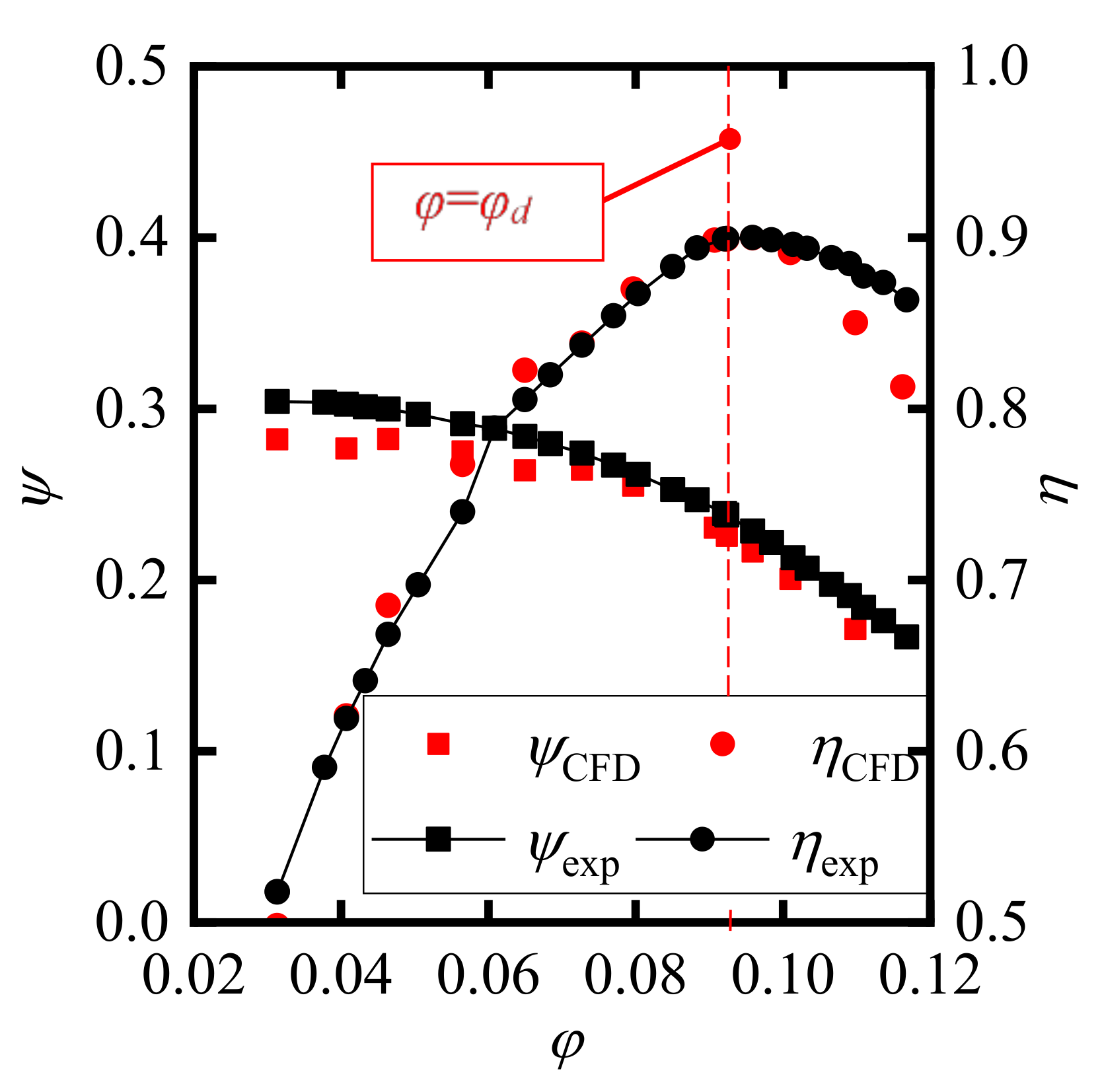
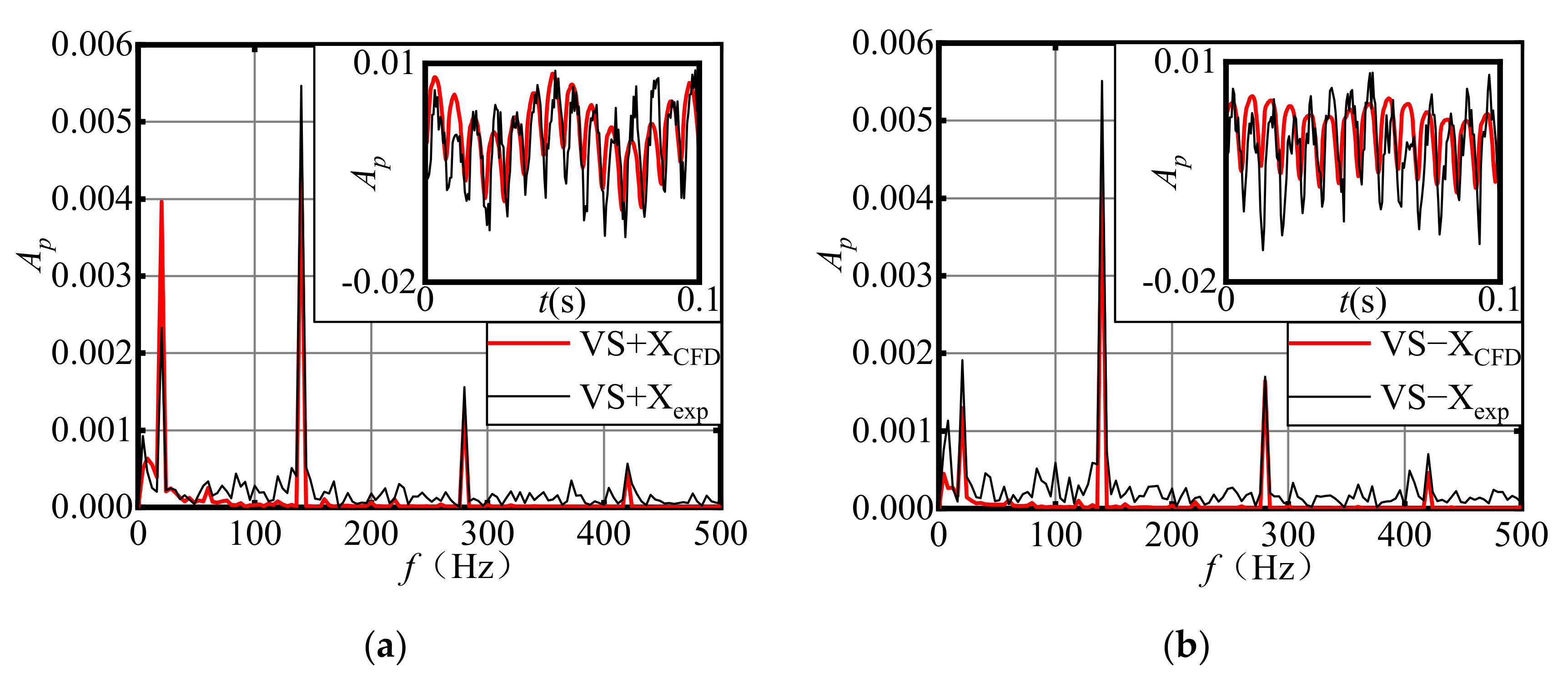
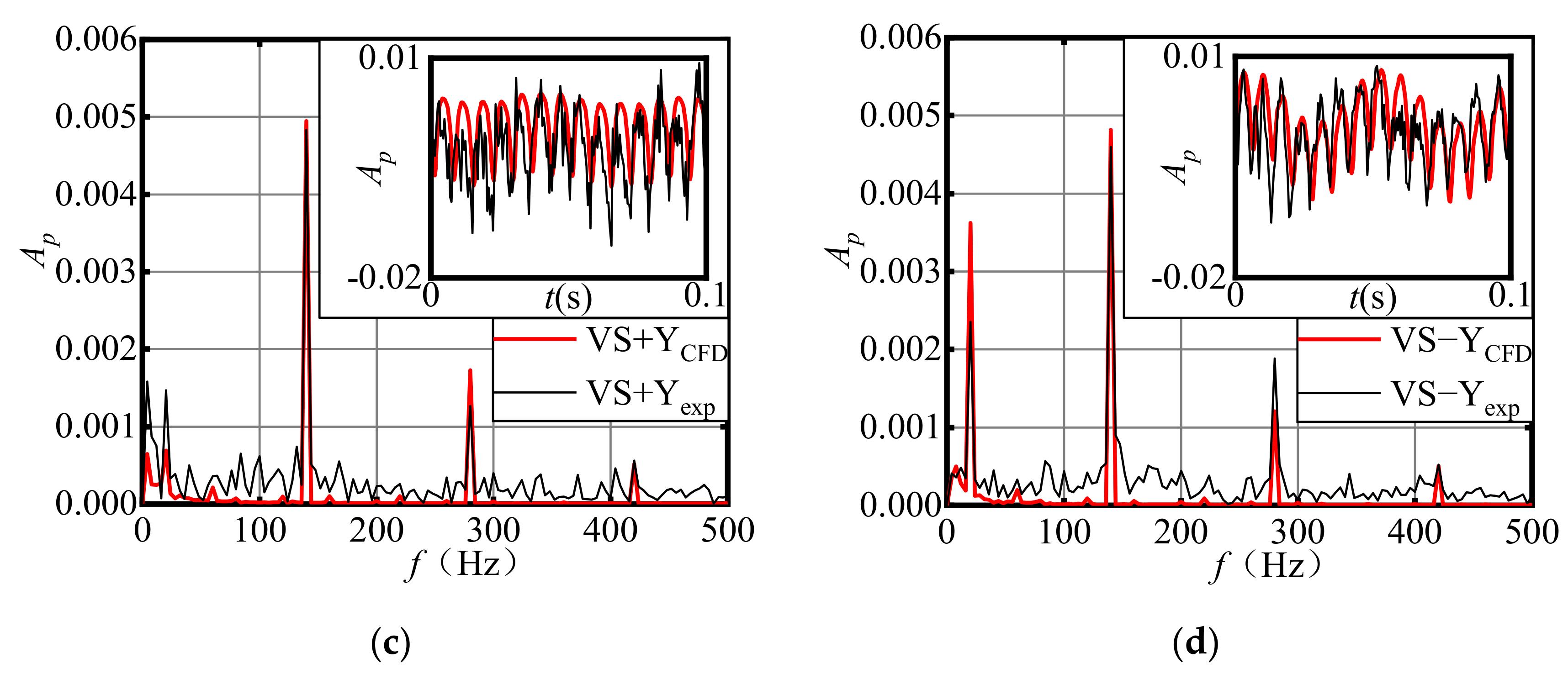



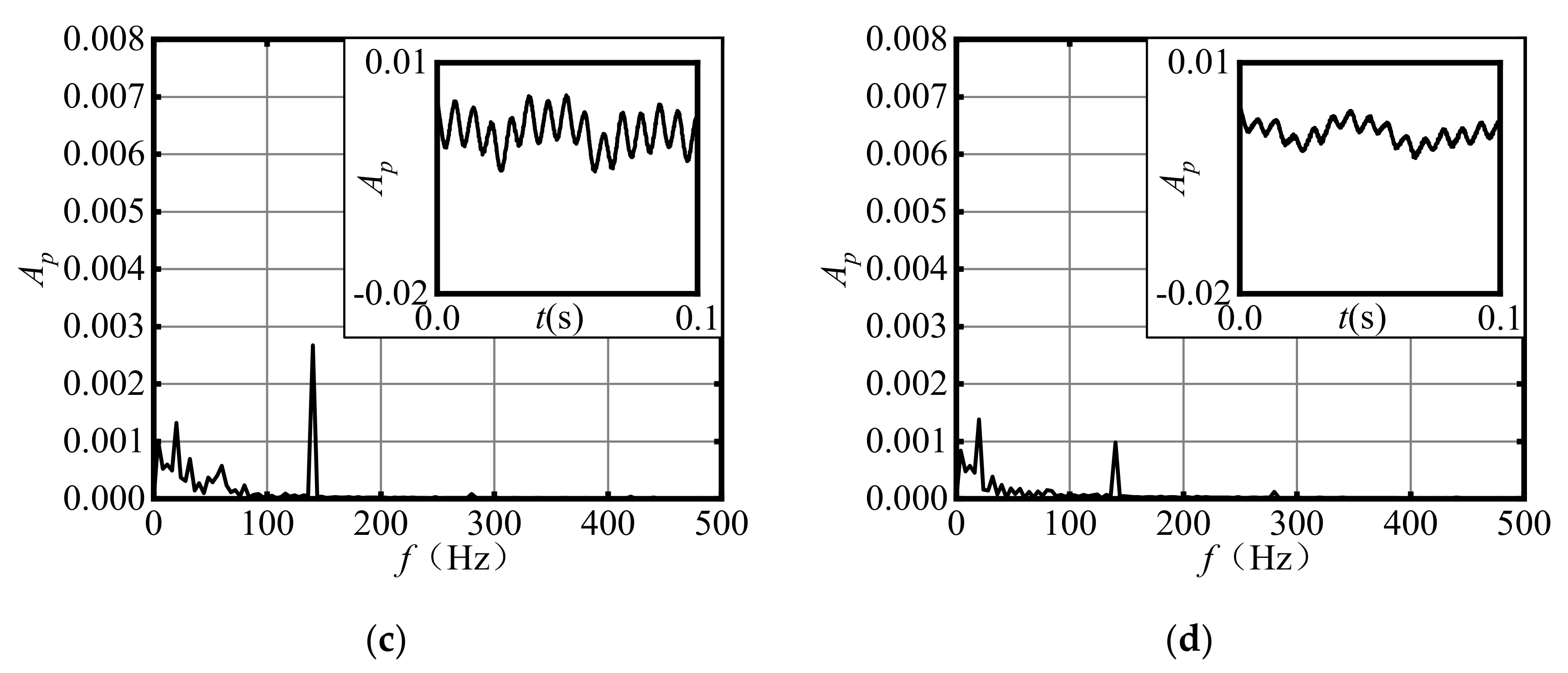
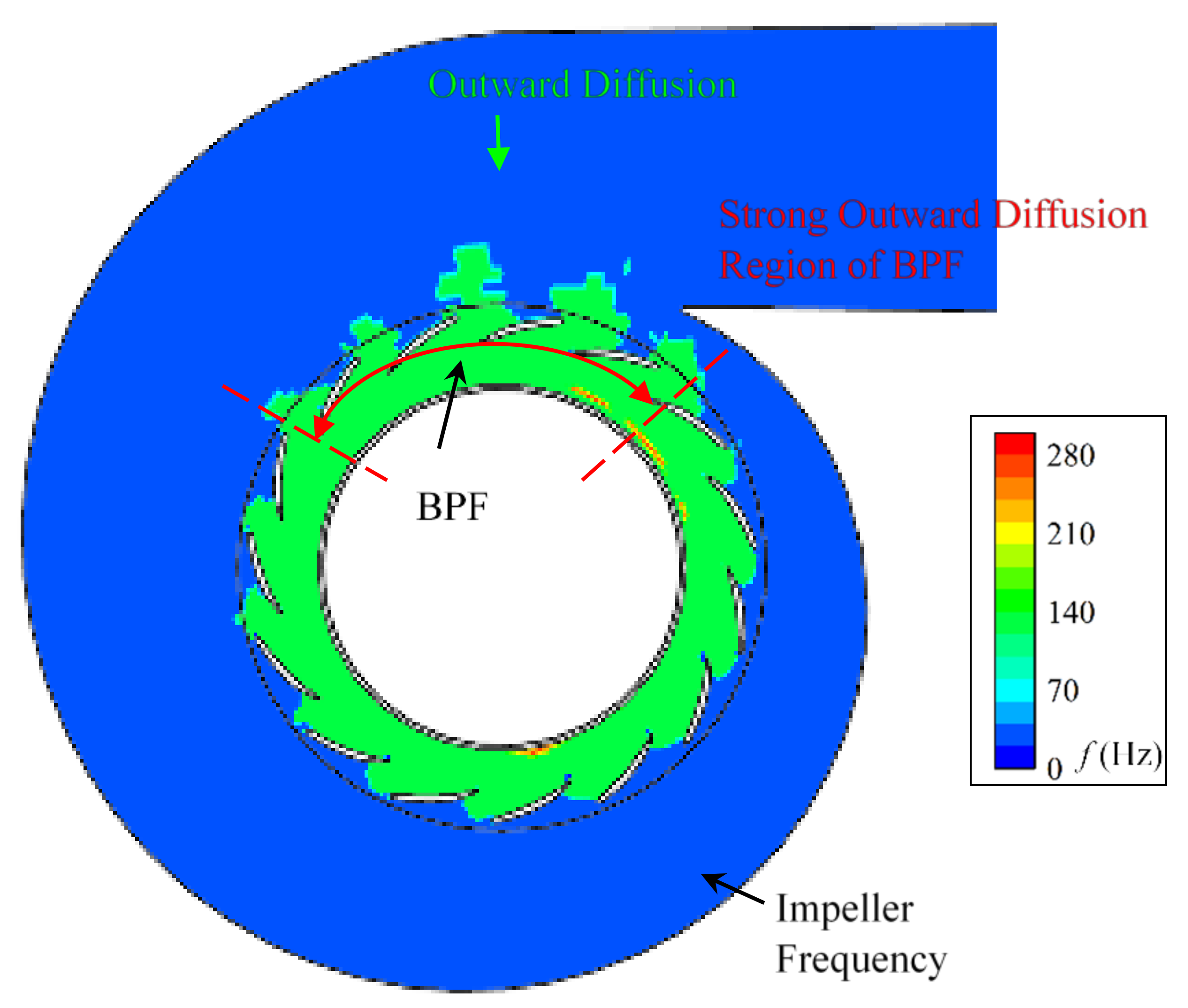

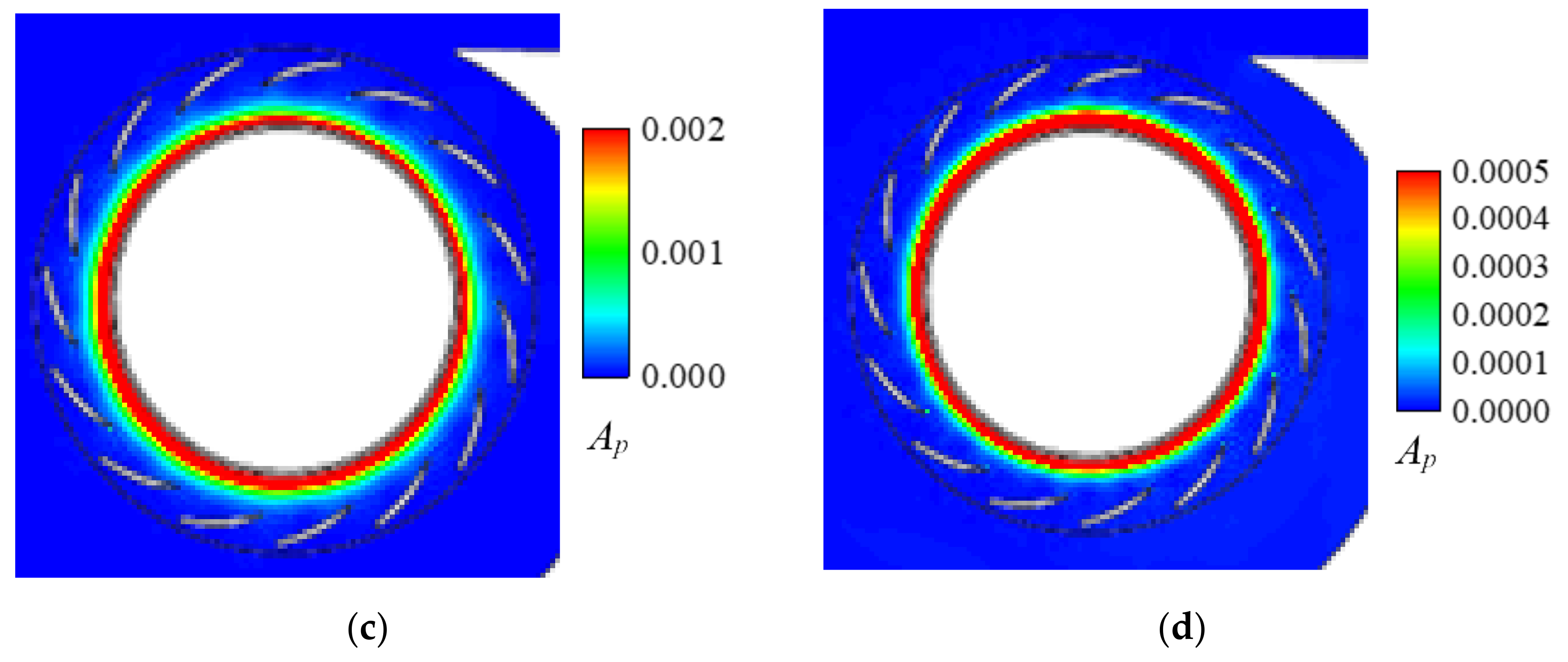
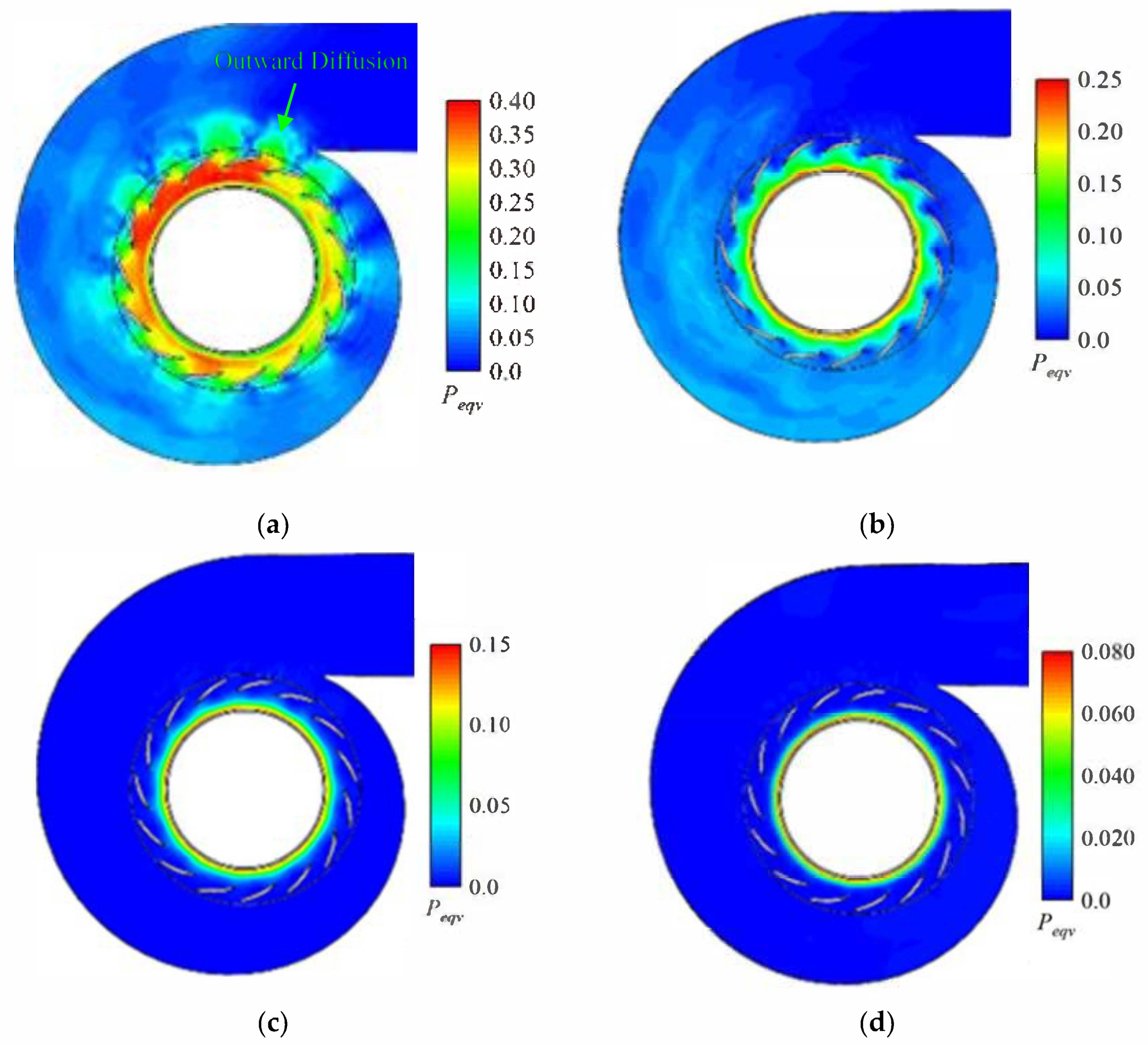

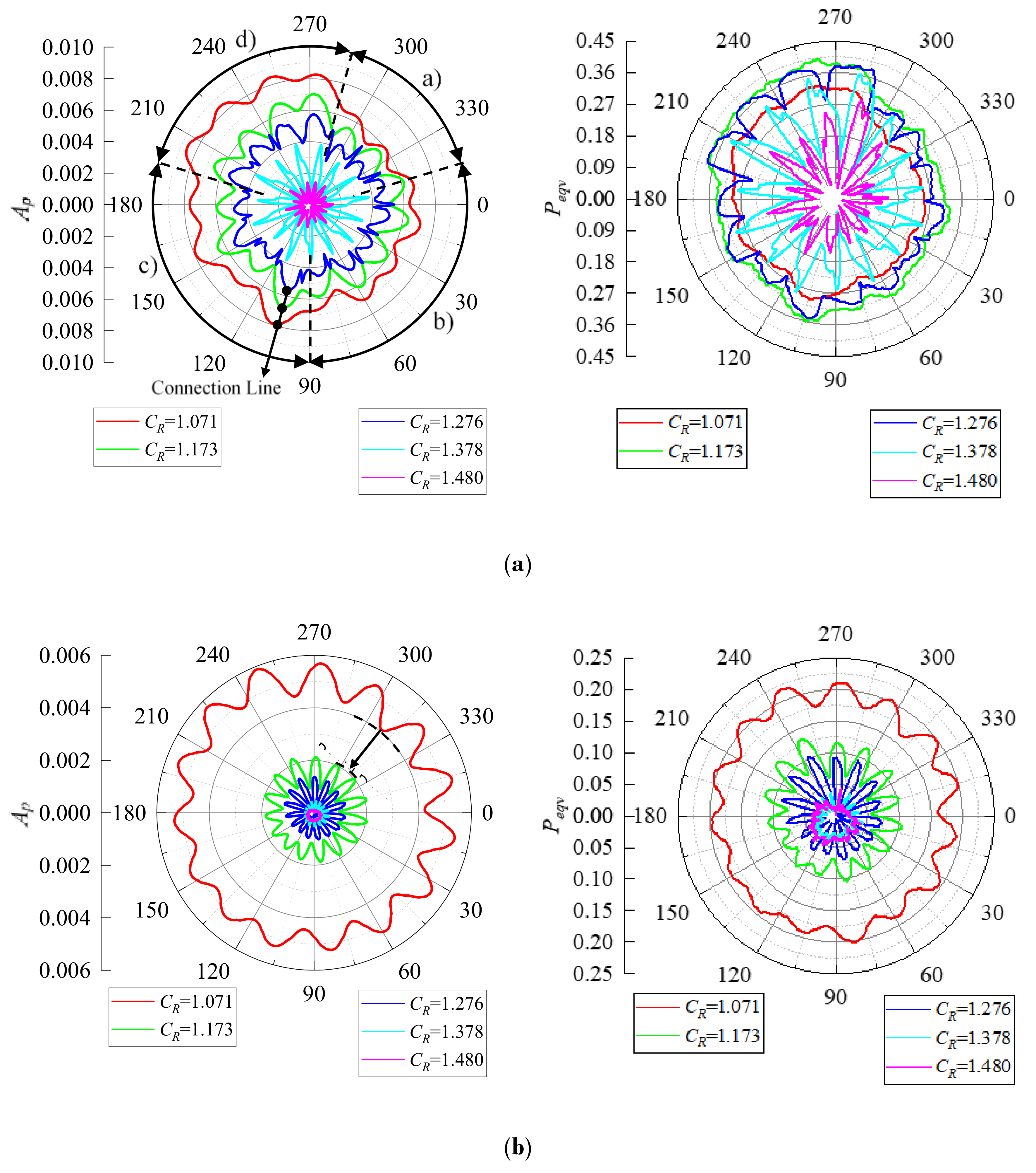
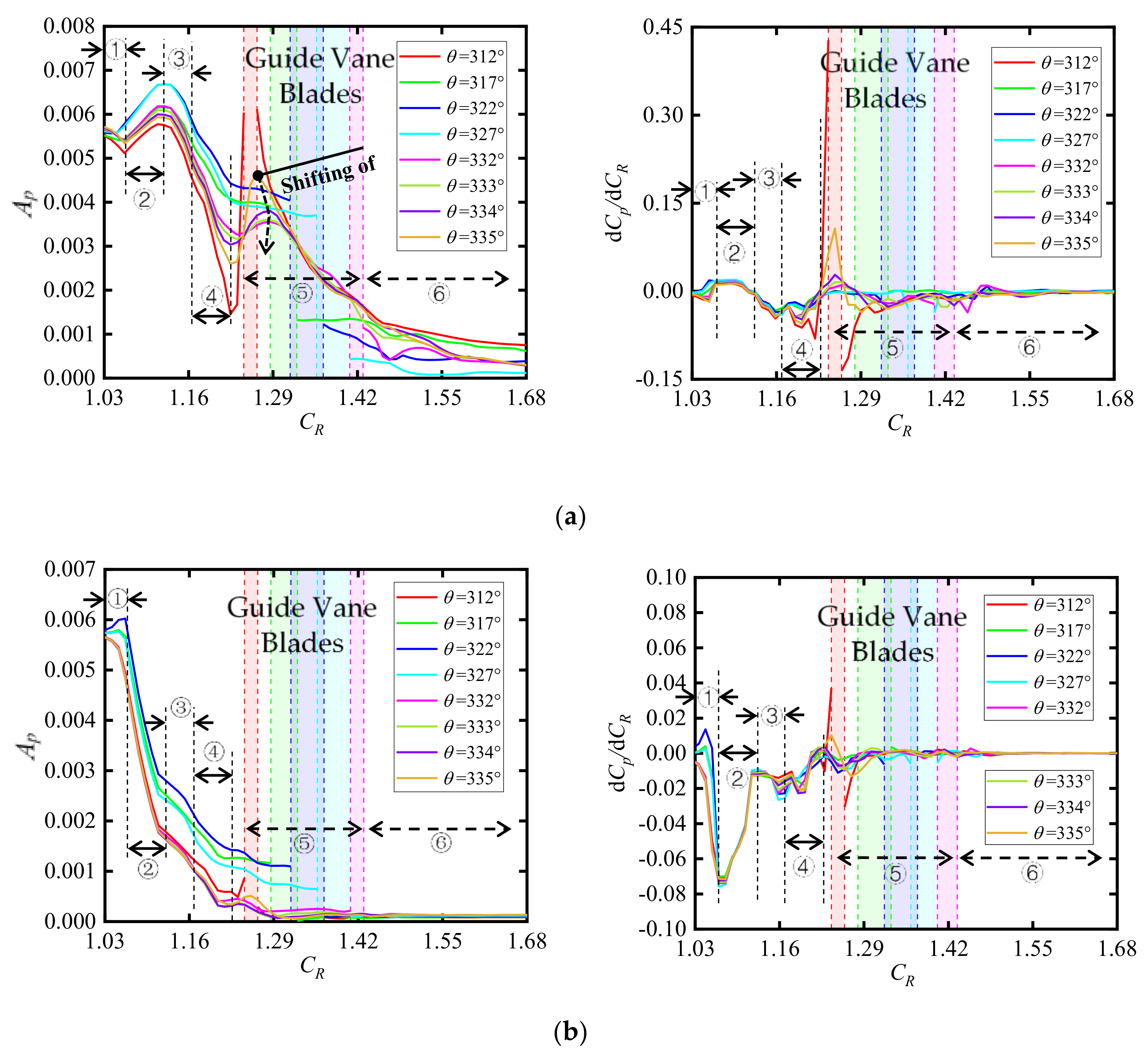
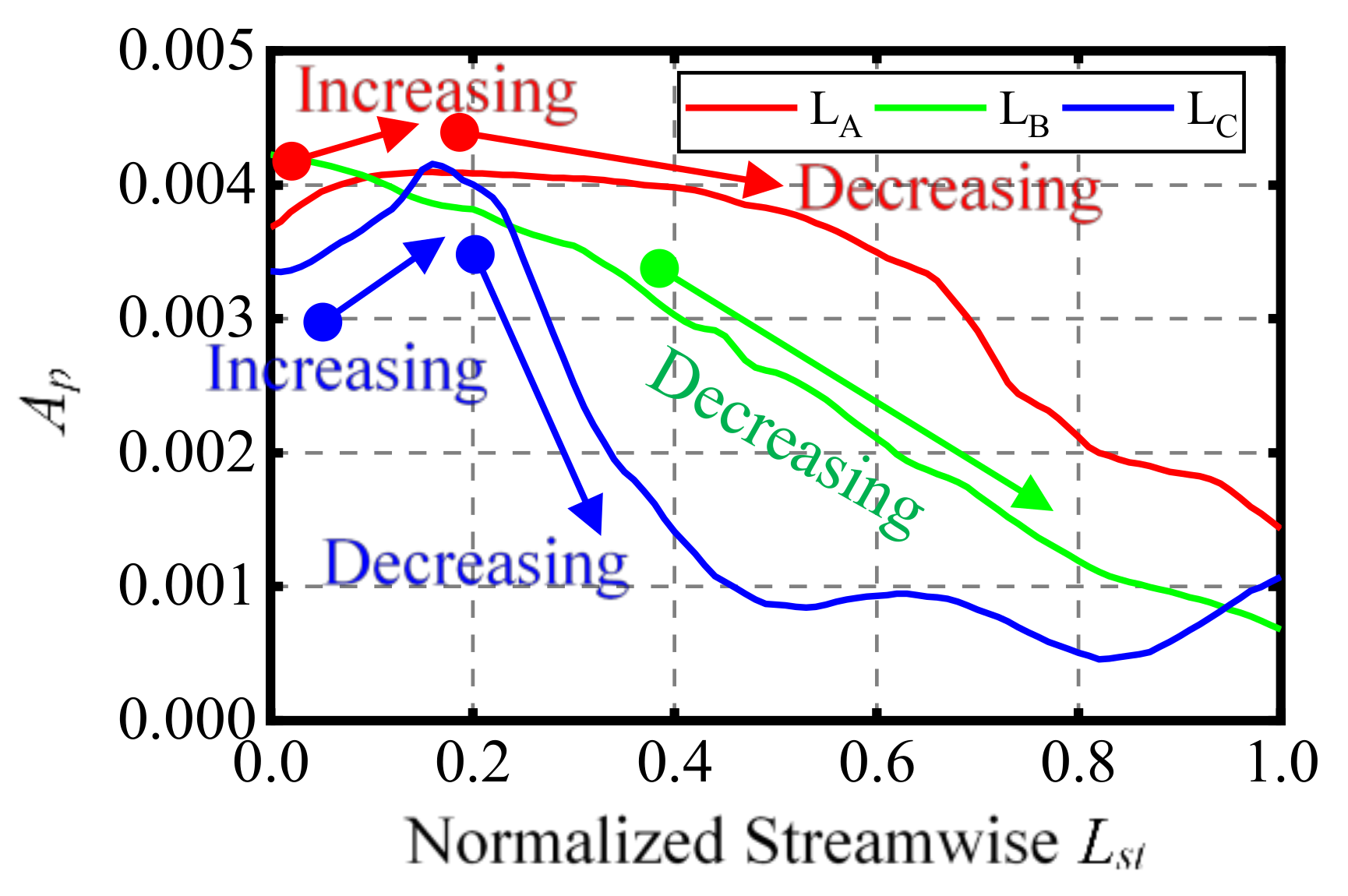

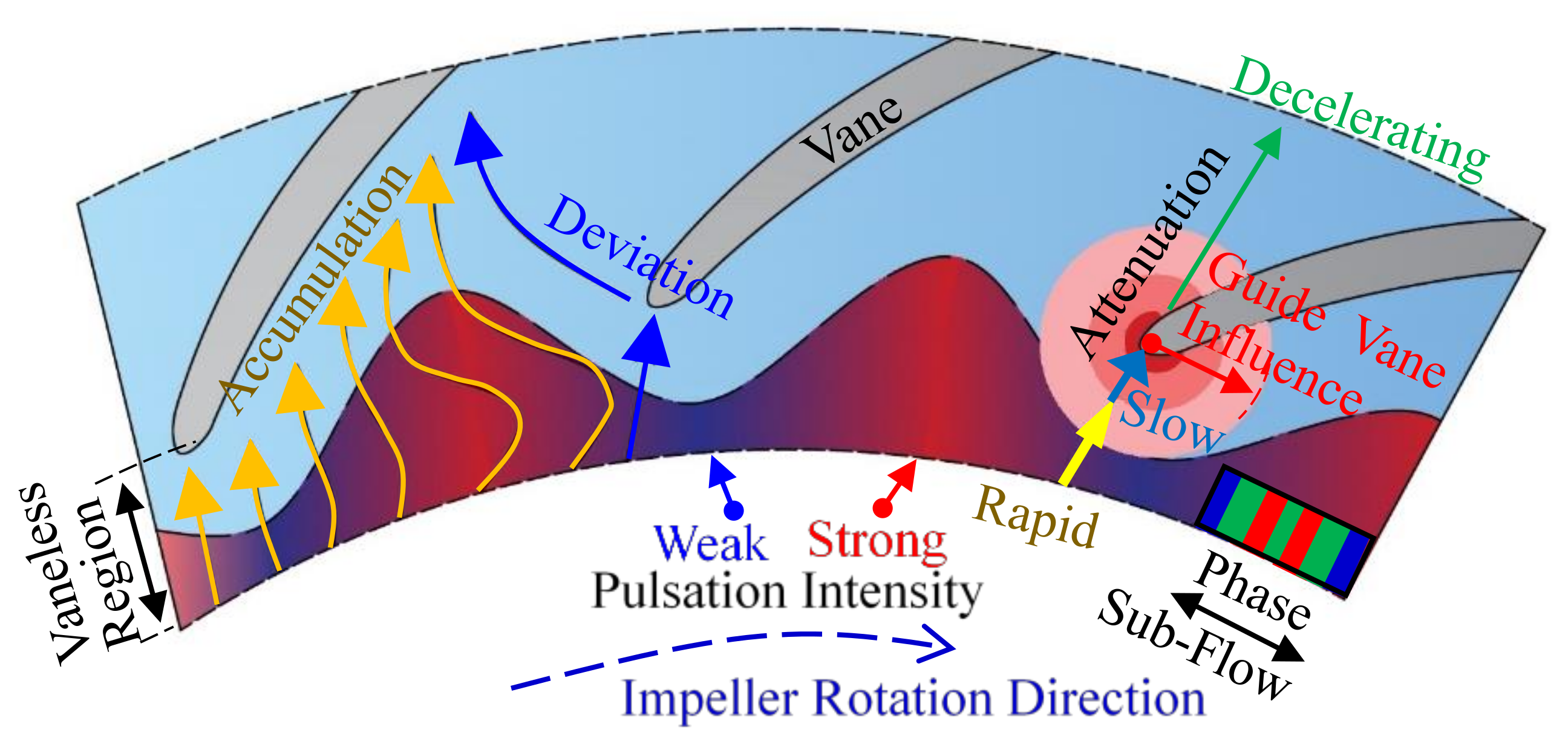
| Parameter | Abbreviation | Value |
|---|---|---|
| Design flow rate | 0.273 [m3/s] | |
| Design head | 22 [m] | |
| Design rotational speed | 1200 [r/min] | |
| Impeller blade number | 7 | |
| Vaned diffuser blade number | 15 | |
| Impeller outlet diameter | 392 [mm] | |
| The inlet diameter at hub | 280 [mm] | |
| Specific speed | 61.72 |
| Quantity | Apparatus | Type | Uncertainty |
|---|---|---|---|
| Flow rate | Electromagnetic flowmeter | Krohne IFC090 | ±0.18% |
| Rotation speed | Rotary encoder | E6B2-CWZ1X | ±0.02% |
| Head | Differential pressure sensor | Rosemount 3051 | ±0.05% |
| Torque | Load sensor | HBM Z3H2R | ±0.05% |
| Pressure pulsation | Dynamic pressure sensor | PCB 112A22 | ±1.00% |
| Variation | VS + XZ=0 | VS − XZ=0 | VS + YZ=0 | VS − YZ=0 | η | H |
|---|---|---|---|---|---|---|
| −20,434 | −28,013 | −19,088 | −25,076 | 89.60% | 21.0574 | |
| −19,253 | −27,842 | −18,338 | −24,589 | 89.67% | 21.0886 | |
| −16,647 | −25,171 | −16,553 | −21,074 | 90.37% | 21.009 | |
| P | 2.177 | 8.40 | 13.4003 | 1.6262 | 4.7155 | 1.9896 |
| −21,793 | −28,030 | −19,835 | −25,183 | 89.59% | 21.0344 | |
| 6.2% | 0.06% | 3.76% | 0.42% | 0.012% | 0.1092% | |
| 8.3% | 0.07% | 4.89% | 0.53% | 0.015% | 0.1364% | |
| −21,793 | −28,030 | −19,835 | −25,183 | 89.59% | 21.1373 | |
| 11.6% | 0.67% | 7.55% | 2.36% | 0.09% | 0.2305% | |
| 16% | 0.84% | 10.20% | 3.02% | 0.11% | 0.2889% |
| Part | Element Type | Nodes | Elements |
|---|---|---|---|
| Inlet | Hexahedral | 203307 | 196776 |
| Impeller | Hexahedral | 1134420 | 1029924 |
| Vaned diffuser | Hexahedral | 1719360 | 1581300 |
| Volute | Hexahedral | 688800 | 665556 |
| Total | - | 3745887 | 3473556 |
Publisher’s Note: MDPI stays neutral with regard to jurisdictional claims in published maps and institutional affiliations. |
© 2021 by the authors. Licensee MDPI, Basel, Switzerland. This article is an open access article distributed under the terms and conditions of the Creative Commons Attribution (CC BY) license (https://creativecommons.org/licenses/by/4.0/).
Share and Cite
Lu, Z.; Tao, R.; Jin, F.; Li, P.; Xiao, R.; Liu, W. The Temporal-Spatial Features of Pressure Pulsation in the Diffusers of a Large-Scale Vaned-Voluted Centrifugal Pump. Machines 2021, 9, 266. https://doi.org/10.3390/machines9110266
Lu Z, Tao R, Jin F, Li P, Xiao R, Liu W. The Temporal-Spatial Features of Pressure Pulsation in the Diffusers of a Large-Scale Vaned-Voluted Centrifugal Pump. Machines. 2021; 9(11):266. https://doi.org/10.3390/machines9110266
Chicago/Turabian StyleLu, Zhaoheng, Ran Tao, Faye Jin, Puxi Li, Ruofu Xiao, and Weichao Liu. 2021. "The Temporal-Spatial Features of Pressure Pulsation in the Diffusers of a Large-Scale Vaned-Voluted Centrifugal Pump" Machines 9, no. 11: 266. https://doi.org/10.3390/machines9110266
APA StyleLu, Z., Tao, R., Jin, F., Li, P., Xiao, R., & Liu, W. (2021). The Temporal-Spatial Features of Pressure Pulsation in the Diffusers of a Large-Scale Vaned-Voluted Centrifugal Pump. Machines, 9(11), 266. https://doi.org/10.3390/machines9110266








